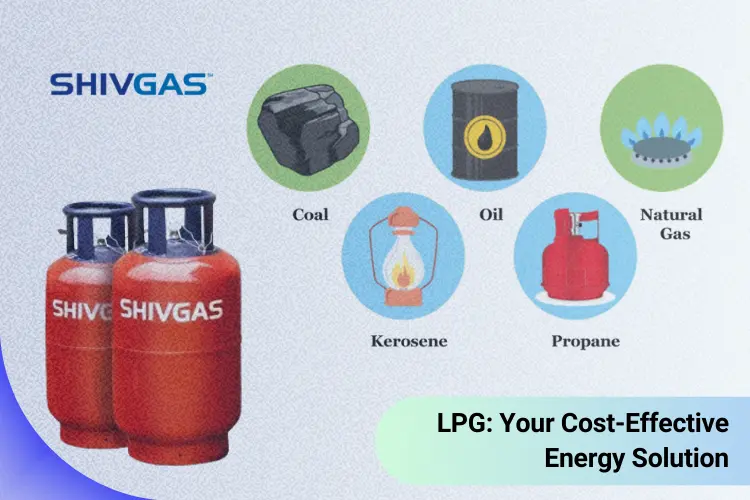
Cost-effectiveness is the first criterion on the lips of every customer and business. Trying to be as economical as possible without compromising on quality, every industry needs a fuel that can fit into this category. Affordability, efficiency and convenience when combined with cost-effectiveness result in an ideal combination- something that not just industries but also households who need both fuel and less expenses, are in search of.
While many try to grapple with this question trying to fixate on an optimum fuel that promotes both sustainability and efficiency, LPG is the straightforward answer.
Although you might be thinking that LPG can be very costly due to its incredible versatility, high calorific value, and precise and uniform heating capability, it is actually not the case. A lot cheaper than its counterpart options such as diesel, petrol and electricity, LPG demands almost zero maintenance in the long run, thereby supplying you with maximum reliability and cost viability in the long run.
This blog explores in depth how LPG- made out of propane, butane, propylene, butylene, and isobutane, fares when put against other counterpart options, with the aim of giving you the basis that will help you make the right decision every single time without being hesitant.
Now, dominating the likes of petrol and diesel, LPG is the number one option for power generation across all vehicles including even light-duty, medium-duty and heavy-duty trucks and tractors. While petrol and diesel are fuels the prices of which tend to keep on being unstable, liquefied petroleum gas on the other hand has a stable price. The main reason why all big industries and companies are supporting the use of LPG in automotive is its eco-sensitiveness. Producing better air quality, LPG makes sure to see that greenhouse emissions are cut down to a large extent. Not only is LPG a more economical and environment-friendly choice, but it also ensures a longer lifespan of the engines due to a cleaner combustion process.
While coal was known to be the traditional fuel that was used for industrial heating, LPG now due to its high calorific value and uniform heating is the go-to fuel that is used for the purpose of both residential and industrial heating and also power generation. Used in stoves, ovens, barbecues, etc, LPG besides its heating applications in households also dominates the industry heating segments for example the entire hospitality industry. A prime reason behind that is the clean burning of LPG which makes sure that associated costs of health expenses and environmental compliance are both avoided. From creating glass and metal cutters to water heaters, LPG has overtaken coal. Coal- although has a very low initial cost, is prone to extremely harmful effects on the body and environment, thus resulting in falling behind a new fuel like LPG.
Natural gas is a popular fuel. In fact, it is even cheaper than liquefied petroleum gas. However, not every area in a country as diverse as India is stocked up with pipelines, thus making LPG the definite stand-out option for every off-grid solution, and backup power generation that is needed in the country. Because of the higher calorific value of LPG, it can provide heat and energy more quickly and with less fuel consumption. This means that LPG is a far more efficient option than natural gas, thus making sure people in need get more quantity and that too at an economical value. This is something that natural gas is not capable of. Thus, the accessibility, efficiency and economic nature of liquefied petroleum gas makes it a better option than natural gas.
Electricity has been for a long time been used in houses and businesses and even across all big industries. However, the major downside of LPG that irks every business and household owner worried about is the cost. The cost per kilowatt hour of electricity is where it gets done by liquefied petroleum. Efficiency is another reason. LPG can supply heat faster and that too at a lower consumption rate- something that electricity is less capable of. Due to this lower energy consumption and cost saving, LPG is now the best preference for all the leading industries as well as across common households.
You May Read: How Much Will You Save If You Switch From Electric to LPG Gas
The best fuel for the environment, not only has LPG left behind fuels like coal and oil long back but has also overtaken untraditional fuels such as Biogas and CNG. Energy solutions are now rampantly growing in all sectors. In a day and age where environmental consciousness is a hugely discussed topic (and rightly so) even in industrial circles, the need for a fuel to stand out as sustainable is supreme. By 2024, all industries have understood that without an eco-friendly, versatile and cost-effective fuel, the chances for them to grow and maximise revenue are almost none. That is why LPG is a clear-cut winner. Optimising operations, maximising profits and leaving a very minimal carbon footprint, contact premium gas companies like SHIVGAS right now to start enjoying a better work and personal life.
About the Author:Having worked as a surveyor all across India, I am known for my in-depth research and data knowledge which leads to writings that helps businesses and consumers make the right choices in terms of optimising their budget and productivity.
Comment (0)